
|
|
||||||||
INTRO
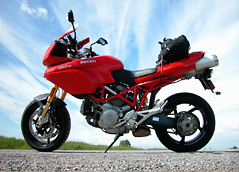 |
|
Is long travel suspension enough to make it an adventure tourer? |
After selling like wet firecrackers in North America for many years, big trailies (as they're called in Europe) or adventure tourers suddenly seem to be a hot item on this side of the pond.
This is due in part to a general shift away from the dirt side of the spectrum to more road touring inclinations. Even Triumph’s Tiger and BMW’s mighty GS have traded in their spoke wheels for cast units, and in so doing, enabling better street rubber selection.
So, as the subject of this test, we decided to compare two of the newer players on the adventure touring scene: the Ducati Multistrada and the Buell Ulysses. We have already published a test of the Ulysses (link), but as we rode it along with the Ducati, it seemed only appropriate to use it as a comparison for the Multistrada.
KISSING COUSINS
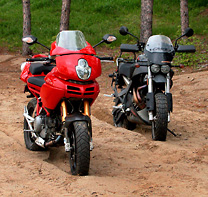 |
|
Not a very happy place for either. |
Notionally, the Multistrada and Ulysses are quite similar – big air-cooled V-twin engines in chassis featuring long, soft suspension, and in line with that similarity they both feel excellent on pavement, but barely competent on gravel. And, well, pretty hopeless off actual roads.
Both have 17-inch tires (road sizes) and both come with the “not for dirt usage” cast wheels. They also both have luggage (optional on the Ducati, standard on the Buell), both require a decent inseam to reach the ground comfortably, and both have quality fully-adjustable suspension – Showa on the Buell, either Marzocchi forks & Sachs shock on the 'Strada or lovely, lovely Ohlins on the 'S' model (we tested the 'S', lucky us).
IN THE SADDLE
The Buell's Sportster-based engine sounds like – well, like a Harley. It rattles, clanks, groans, mutters, hisses and generally makes you think of shaking a coffee can full of bolts. Although the Ducati is not exempt from some mechanical clatter, it’s not as audible as the Buell’s and is mostly covered from a delicious intake sound (although we found the exhaust to be sadly muffled).
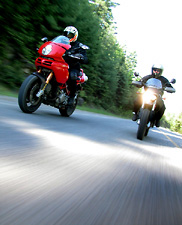 |
|
Lots of fun. |
Engaging the clutch is a bit of a struggle on both, for different reasons. The Buell has a very long reach, at least if you have normal sized hands, but with relatively easy action; the Ducati's reach seems normal, but the pull is heavy.
Once underway, the Ducati's gear change feels positively Japanese, and that's meant as a compliment. It's smooth, quiet and slick; absolutely no grief whatsoever. The Buell's throw feels a bit Massey-Ferguson by contrast, although it's still probably the best Buell/Harley transmission in our collective memory. It was positive enough, but just needed a slow and firm prod.
Both motors have lovely characteristics, and just what you’d expect from a V-twin – very tractable with the more technologically advanced Ducati getting the nod overall. In the words of Mr. Lewis, it’s rather intoxicating and entertaining – should that be intoxertaining? Both have rather low and immediate “headbutt-the-screen” limiters that take a while to get used to, with the Duc hitting the wall at 8,750, whereas the Buell calls an end to the fun at a lowly 6,500.
Good fuel injection on both equates to no flat spots, although both have some vibration, especially at lower revs, but smoothes out at cruising speed (the Buell's trick rubber mounts work nicely as the revs rise, as well).
SUSPENSION
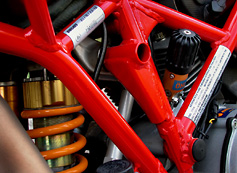 |
|
The 'S' model comes with Ohlins! |
Differences come a bit more obvious when you start riding quickly, especially on the sort of bumpy back roads CMG tests tend to favour.
The Ohlins shock and forks on the Multistrada S initially feel rather firm, contrary to the expectation of the usual dual-sporty soft ‘n’ bouncy style. But there's still decent travel, and although potholes are felt, they do not affect the chosen line – they are simply absorbed.
The American challenger, on the other hand, has a fantastic pampering feel to it, its soft and fluffy suspension taking some of the precision out of its chassis whereas the Multistrada deals with any surface and feels like a taut track bike to boot – stable and well-controlled, with superb road feel.
Overall for comfort, you'd have to give the Buell the nod; the suspension is simply superb at absorbing any sort of road imperfections. The Ducati is still very good, providing better road feel, but more than one tester thought the Buell had perhaps the most comfortable suspension they'd ever tried – high praise indeed.
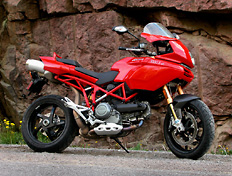 |
|
Front fairing has a weird split. |
When you have to slow down, no complaints on either braking system. Buell's unique perimeter disc does work and both systems provide good power and feel; no complaints then.
COMFORT
Still on the road, both seats and riding positions worked well for a wide spectrum of rider sizes. The Buell positions the rider a bit more upright, the Ducati a bit more aggressively, and although the Buell seat looks like it would be tons more comfortable, they both work well.
Oddly, even though the Ducati has a higher claimed seat height, shorter riders found the Buell felt noticeably taller – no doubt that comfy seat is that much wider at the front. It's tall* enough, in fact, that anyone under 5-10 found the bike quite scary to start and stop, let alone deploy the sidestand!
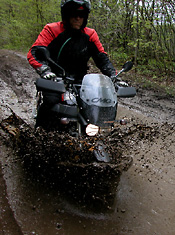 |
|
The Ulysses can be made to do it, but it takes nerve. |
* Note – for '07, Buell has taken 33 mm out of the ride height, so that complaint should be history with the new machine, making its potential appeal much broader.
The Ducati had one huge advantage on the open road; the odd fairing (which has sadly received a savage beating with the ugly stick). The upper screen turns with the bars and the lower part is fixed, but it does an amazingly good job of moving air around the rider. It's quite shocking how efficient it is, really, considering the minimal surface area.
The Buell's “fairing”, on the other hand, appears to be simply decoration as far as we could tell. None of us could detect any useful effect from it whatsoever, leaving any breaking of wind to the rider after luncheon.
OFF ROAD
If you are silly enough to take the off-road looks seriously, you're going to get into big trouble pronto. Both bikes feel tippy and edgy on anything looser than a hard-packed gravel road; any kind of loose gravel, or God forbid actual dirt, had the riders mewling in fear inside their helmets.
The front end of the Buell in particular was not a friendly thing at all; a series of downhill curves on a fresh gravel surface was terrifying. The previous test of the Buell was done mostly after off-road riding, and it seemed that survival (of both bike and ‘arris) was a big surprise to all. Having said that, the Buell does at least have some semblance of off-road protection and ability, whereas the Multistrada doesn't even try.
INSTRUMENTS
 |
|
Editor 'arris gives Mr. Lewis a helping push. |
On the road, you do look at the instruments occasionally, and we thought both bikes came up short on this one. While the Buell’s main instruments are easily readable and it has the usual bits including a double tripmeter, it could use a fuel gauge instead of its mingy and not overly obvious low fuel warning light.
Mr. Lewis managed to run it out on one back road (admittedly, he likes to play a bit fast and loose with his tank refills). Fortunately for us all, it was within sight of the gas station where we all waited, enjoying our ice cream and watching with interest as he pushed and staggered up the long hill (Editor 'Arris finally took pity and went to 'elp when he finished his cone).
The Ducati has a remarkably complex dash panel, apparently with all sorts of interesting functions including distance to empty, average fuel consumption, etc., Unfortunately, none of us could get the bloody thing to work as it should. Tiny buttons, a confusing adjustment regime, and intermittent resets and changes all by itself were enough to make all of us crazy with fury every time we tried to set a function.
Oh, and when we did manage to get the fuel gauge displaying the way we wanted it, it often indicated close to bleedin' empty when there was barely a quarter of a tank used. A notched dipstick would have been more useful!
THE OTHER BITS
 |
Speaking of junk, both companies should send their mirror designers to the back of the class. Fuzzy, vibey, badly aimed – you really wouldn't think it was that hard, would you now? Especially with a big set of wide bars to give them a chance to reflect the world behind (Ducati for '07 says they have new “anti-vibration” bars, so theirs may be better now).
Neither bike provided a centrestand, and looking at the undercarriage it's no surprise; be pretty hard to fit one. It's not so critical on the Buell with its no-lube belt drive, but on the Ducati we expect lots of chain replacements as owners take the easy way out.
At least the Ducati sidestand works nicely and feels strong. The wobbly twig nailed to the Ulysses feels as though it's barely attached, and has a highly disconcerting amount of flap at its fully-extended position. Without exception, every rider on the Ulysses worried about leaving it standing by itself without two or three exploratory tugs on the bar to be sure the stand was set.
CONCLUSIONS
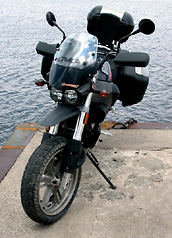 |
|
The Buell exceeded expectations, despite the dodgy sidestand. |
So after all that – do the notional similarities up front get faded out by their individual riding experience? Absolutely. In fact, after a day on them you're left shaking your head at just how different they feel, despite all their general similarities. Both surprised us, actually, by how competent and fun they are over a day or two on the back roads of Eastern Ontario.
Overall, the Multistrada feels more sophisticated, smoother, more controlled, with a wonderful engine that's willing to yank you to hell and gone at your tiniest whim.
The Ulysses has this great, roary, thrashing motor that despite its limited rev range actually delivers a pretty decent wallop of power and proves itself to be a willing companion as much as the Ducati does, albeit in a much brawnier, noisier, in-your-face kind of way. Some testers liked it at once, some came to appreciate it only after a few stints in the saddle. The package is also a little softer, a little more comfortable than the Ducati.
Big trailies? Not even close. Adventure tourers? Hmhh, not really. But damn good packages, both of them, thanks to their excellent overall comfort, handling and engine character. Don’t think about getting adventurous in the dirt though and if little things like bad instruments, mirrors and lack of a centrestand don’t bug you then you can’t go far wrong.
Do we have a favourite? Not really; it's one of those mood things, you know? Both will do what you want (as long as you stay on the roads), just with a different attitude. I will say this: I've ridden and enjoyed several Buell and Ducati models over the years but would never have considered buying one of either. In this case – I'd actually consider owning either one. Truth.
2007 UPDATES
 |
For '07, both bikes have changed. As noted above, the Ulysses has dropped the seat height by 33 mm while maintaining lots of suspension travel, which should make it a much nicer bike unless you're already in the six-foot-plus level. It's now also sold sans bags which has dropped the price by $510.00.
The 'Strada has had its engine bumped up to 1,100 cc thanks to a 4mm increase in its bore, and the new bars should improve the mirrors. They also claim to have improved fuel level and tripmeter functions as well as the comfort level of the seat. And as a real bonus, the price of the standard and S models have both dropped by $1,000 this year.
COMPARITOR
|
Specifications |
Buell Ulysses XB12X | Ducati Multistrada 1100 [S] |
Comments |
|
MSRP |
$13,859.00 | $14,995.00 [$17,995.00] |
There's
about a grand between them – the price of Italian chic? Strada
S version gets the Ohlins suspension for an extra 3 grand.
|
|
Displacement |
1203 cc | 1078 cc |
Buell
has over 100cc more capacity.
|
|
Engine type |
V-Twin, air/oil/fan cooled | V-Twin, air/oil cooled |
Almost
identical ... not. Ducati has a wider 90 degree V with desmo valve
operation compared to the Buell's 45 degree V and pushrod operation.
There's your extra grand right there.
|
|
Carburetion |
Fuel Injection | Fuel Injection |
Hmhh,
yes, very interesting.
|
|
Horsepower |
103
hp @ 6800 rpm
|
95
hp @ 7750 rpm
|
Considering
the lower tech spec of the Buell, it does well at pumping out
the extra power you'd expect from a 100cc gain. Interestingly,
the Ducati revs higher yet produces it's maximum torque lower
down.
|
|
Torque |
84
ftlb @ 6000 rpm
|
76 ftlb @ 4750 rpm | |
|
Final drive |
5 speed, toothed belt drive | 6 speed, chain drive |
I'd
have thought with large torquey motors, that five would be enough
...
|
|
Tires, front |
120/70 ZR17 | 120/70 ZR17 |
Not
exactly dirt tire sizing.
|
|
Tires, rear |
180/55 ZR17 | 180/55 ZR17 | |
|
Brakes, front |
Single 375 mm disc with 6-piston caliper | Dual 320 mm discs with 4- piston calipers |
Buell stick
with their funky perimeter front brake whereas the Ducati keeps
it all standard.
|
|
Brakes, rear |
Single 240 mm disc with 1-piston caliper | Single 245 mm disc with 2- piston caliper | |
|
Seat height |
808 mm (31.8") | 850 mm (33.5") |
With
Buell dropping the seat height in 07, there's now quite a difference.
What the figures don't show is that the Buell's wider seat makes
it feel taller than it is.
|
|
Wheelbase |
1374 mm (54.1") | 1462 mm (57.6") |
Buell
love to come out with short wheelbased machines. Might explain the
remote front end in gravel.
|
|
Dry
weight |
193 Kg (425 lbs) (claimed) | 196 Kg (432 lbs) (claimed) |
Not
much in it.
|
|
Colours |
Orange, Black | Red [Red, Black] |
Right,
yes, okay.
|
| Warranty |
24
months
Unlimited Km |
24 months
Unlimited Km |
Two years on both is pretty good. |
![]()